Ferrari 375. The weapon of murder!
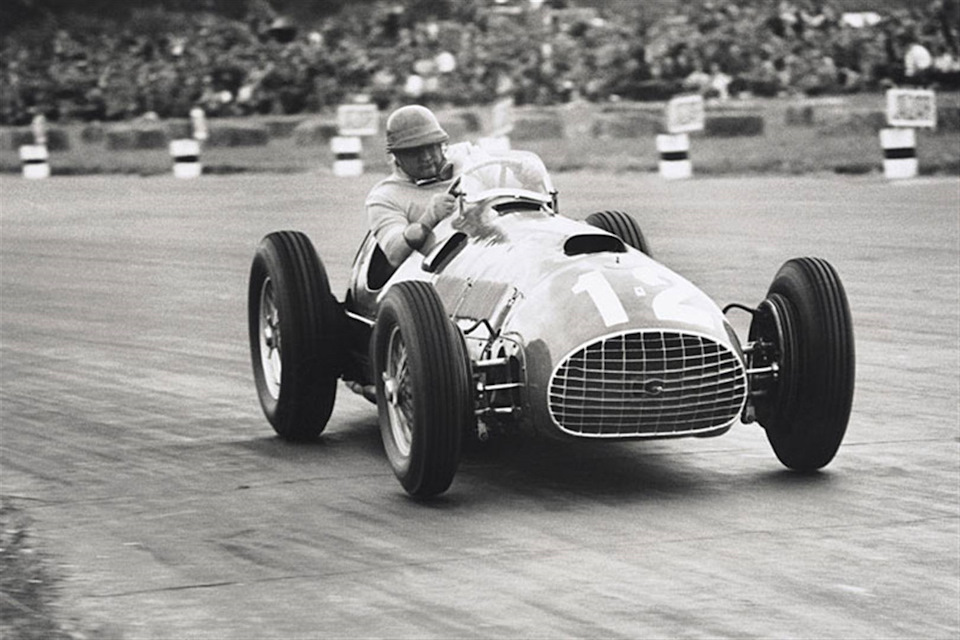
"I had tears in my eyes. On the one hand, I was happy, but on the other, there was a feeling that I killed my own mother, "- Enzo Ferrari about the first Ferrari victory over Alfa Romeo in the British Grand Prix '51.
The first motor racing in post-war Europe was held four months after the surrender of Hitler's Germany. At first, cars started to start, which were lucky enough to survive during the war, regardless of class. The race was growing, the first post-war Great Prizes were held and in October 1947 the International Automobile Federation (FIA), established a year earlier on the basis of the former International Association of Recognized Automobile Clubs (AIACR), approved a new technical regulation for Grand Prix cars. In the most powerful class, called Formula-A, cars with atmospheric engines up to 4.5 liters capacity or with engines with supercharged capacity up to 1.5 liters could start. In the weaker class, called Formula-B, the maximum volume of atmospheric motors was 2 liters, and the inflatable - 500 cm³, and in the weakest, Formula-C - the same 500 cm³, but without the supercharging. The pre-war rules provided for a different ratio of the working volume: in the Grand Prix class, 4.5-liter atmospheric engines were opposed by 3-liter supercharged engines, and in the "voyurettet" class - 2 and 1.5 liters, respectively. The new regulations of the FIA killed two birds with one stone. First, the power ratio between engines with supercharging and without it became much more fair, and secondly, in the same class could compete as the French Grand Prix machines with 4.5-liter engines that remained from the late 30s, and Italian and British compressor "vyutyurety." Later, when the letters in the designation of classes were replaced by numbers, Formula-A turned into a familiar formula for all of us.
One of the first manufacturers to create absolutely new cars for the Grand Prix, was the company Ferrari. On the post of chief designer Enzo Ferrari invited Joachino Colombo, who was removed from work in Alfa Romeo because of the fact that before the war he was a member of the fascist party. Legend has it that when in July 1945 the speech came about the engine for the future sports car between Ferrari and Colombo the following dialogue took place:
"Maserati has a first-class quartet, the British have a six-cylinder ERA, Alfa Romeo has an excellent" eight, "Joachino shared his thoughts. "I think we should build a 12-cylinder engine!"
"Darling, Colombo!" Answered Enzo. - You are reading my mind! For several years I dreamed about this engine.
In August '45 Colombo made the first sketches of the future car with a 1.5-liter V12, and in November the finished drawings were transferred to the plant. True, to build the first car, bearing the brand "Ferrari" had already without Colombo, who returned to work in Alfa Romeo. The main designer was Giuseppe Busso, who previously built aircraft engines in the same Alfa Romeo, and Enzo's engineering adviser - Aurelio Lampredi.
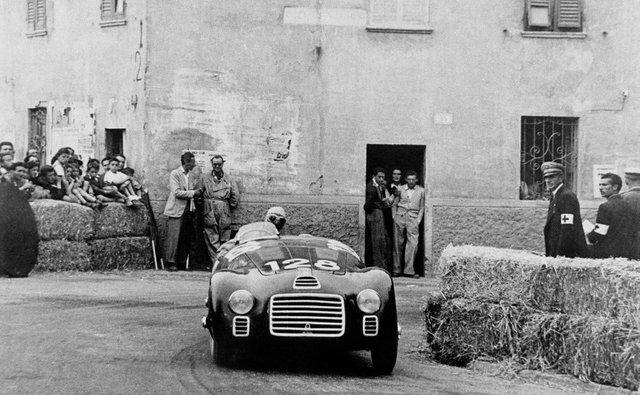 The debut of the car "Ferrari" in the race. Franco Cortese driving a Ferrari 125 S. Piacenza, May 11, 1947
The debut of the car "Ferrari" in the race. Franco Cortese driving a Ferrari 125 S. Piacenza, May 11, 1947
First-born was a sports car Ferrari 125 S, having a capacity of 65 hp first, and later 72 hp. At 5400 rpm in the version with one carburetor and 118 hp. At 6800 rpm with three Weber carburettors. For the first Formula 1 Ferrari car known as 125 GP or 125 F1 (since the names of the first cars were given by the volume of one cylinder, there were three versions of the Ferrari 125: Sport, Competition and Grand Prix) Joachino Colombo, in September 1947, returned to Enzo , Applied the compressor Roots, which increased power to 225 hp. At 7000 rpm. The diameter of the cylinder exceeded the stroke of the piston (55 × 52.5 mm), which was unusual at that time. In 1949, when the power reached 250 hp, Alberto Ascari brought the first Grand Prix of Formula-1 for Ferrari, as an independent manufacturer, winning in Switzerland. By the end of the year, the "Ferrari" cars received a two-stage supercharging and the head of the block with two camshafts with a gear drive, which made it possible to achieve a return of 286 hp. At 7500 rpm, and brought two more major victories: Askari won the Italian Grand Prix in Monza, and British privateer Peter Whitehead - Grand prix of the Czech Republic in Brno.
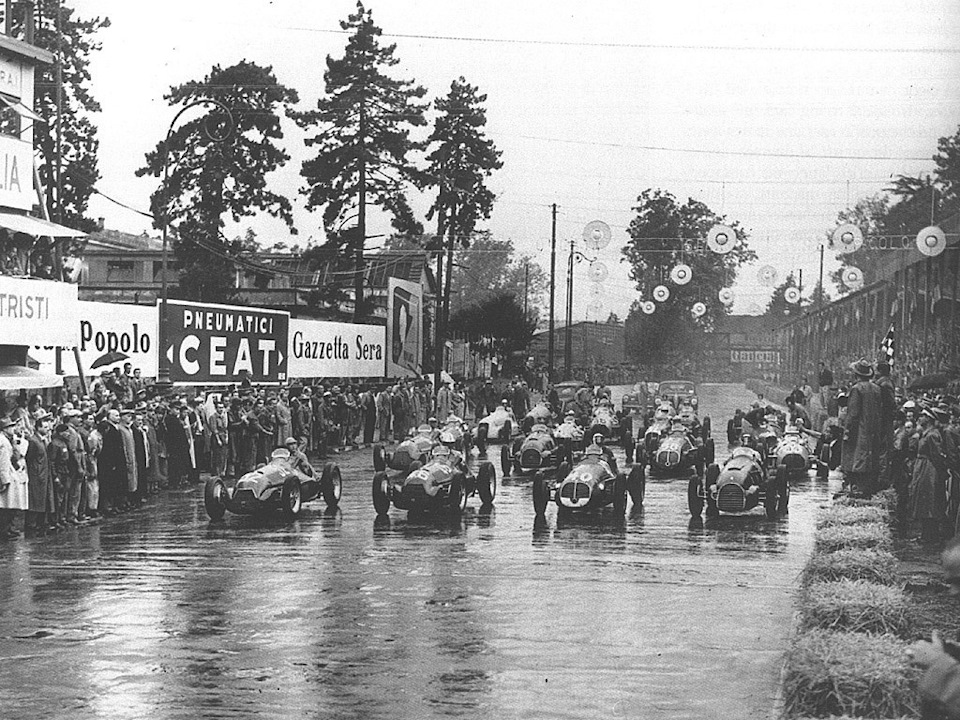 Turin, September 5, 1948 Riders and spectators froze in anticipation of the start of the Italian Grand Prix. First row (left to right): Jean Pierre Wimill (# 52), Carlo Felice Crosse (# 46, both Alfa Romeo 158), Luigi Villorsi (# 40, Maserati 4CLT / 48) and Raymond Sommer (# 28, Ferrari 125 ).
Turin, September 5, 1948 Riders and spectators froze in anticipation of the start of the Italian Grand Prix. First row (left to right): Jean Pierre Wimill (# 52), Carlo Felice Crosse (# 46, both Alfa Romeo 158), Luigi Villorsi (# 40, Maserati 4CLT / 48) and Raymond Sommer (# 28, Ferrari 125 ).
It is fair to say that these victories were won largely due to the lack of Alfa Corse - the most powerful team of the postwar Great Prizes. Alfa Romeo had the best car created by Joachino Colombo under the leadership of Enzo Ferrari back in 1938, Tipo 158, whose in-line 8-cylinder engine with a two-stage Roots compressor in the '48 season produced 271 hp. At 7500 rpm. In the hands of such legendary pilots as Jean-Pierre Wimille, Count Felice Crosse and Achille Vartzi, the Alfetts were invincible. Milanese missed the season '49, but were going to return to the next, when the first World Championship for cars of class F-1 was due to take place. The idea of holding the world championship came at the General Assembly of the FIA from the delegate of the National Automobile Club of Italy Antonio Brivio-Sforza, the famous rider in the past, which is quite logical, since the cars from the Appenin peninsula, Alfa Romeo, Maserati and Ferrari, were the main favorites of the Grand Prix . Deciding to keep up with the International Motorsports Federation (FIM), which in 1949 successfully held the first World Championship in highway and ring races, the proposal was accepted.
In addition to the first victories in the 49th Scuderia Ferrari suffered and several annoying defeats. In the Grand prix of Belgium and France, the drivers of the Ferrari lost, respectively, to Louis Rosier and Louis Shironu on the Talbot-Lago T26C. French cars equipped with atmospheric 4.5-liter engines, spent much less fuel and their drivers could overcome the distance without refueling. Ferrari already understood that with the current car, the limit of which was already achieved, it would be incredibly difficult to defeat Alfa Romeo, and Lampredi, who believed that the time of gluttonous compressor motors had passed, urged him to abandon the supercharging and build a car with an atmospheric engine Large volume. The losses in Spa and Reims finally convinced Enzo that Lampredi was right. Aurelio was appointed the new chief designer of Grand Prix cars, and Colombo was sent to the Gran Turismo machine department.
 Atmosferny engine 4.5-liter V12, created by Aurelio Lampredi.
Atmosferny engine 4.5-liter V12, created by Aurelio Lampredi.
Lampredi took as a basis the original version of the V12 engine with a 60 ° camber angle created by Joachino Colombo, with one camshaft for each cylinder head with a chain drive and two valves per cylinder with an atypical angle of 60 ° between them for Italian racing motors. In the valve drive, as in the 125th, hairpin springs were used. Such a solution had several advantages: springs were less affected by high temperatures, valve rods were cooled better, and vibration was reduced. Of the disadvantages - a higher mass, complexity of manufacture and cost in comparison with the usual twisted springs. The Thinwall sliding bearings produced by the British firm Tony Vanderwell were a good decision, which Lampredi also did not refuse. The cylinder block and the block heads were made of silumin. An important difference from the Colombo motor was the fastening of the steel cylinder liners to the heads by the studs, like the Alfa Romeo 158. A new gearbox was also created - a 4-speed gearbox, combined with a rear differential, instead of the previous 5-speed gearbox, immediately behind the engine.
The chassis of the new car was created anew, although in general its architecture corresponded to the latest version of the 125 GP: a spar frame of oval tubing with a tubular frame to which aluminum body panels were attached, an independent front suspension with double wishbones, a rear suspension of the De Dion type With two pushing rods, transverse leaf springs with hydraulic shock absorbers in front and rear. The dry weight of the car was 815 kg, which was 115-120 kg more than the Alfa Romeo 158, but fully compensated for less fuel at the start.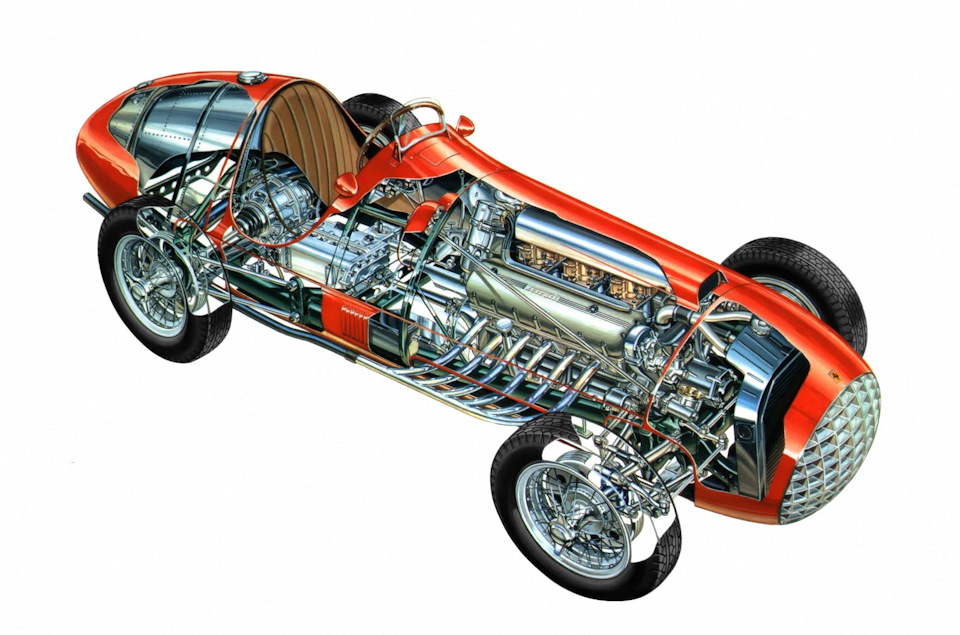 Ferrari 375.
Ferrari 375.
Ferrari missed the opening of the first World Championship of Formula 1, held in the English Silverstone, and the next two races in Monte Carlo and the Swiss Bremgarten exposed the old 125th. The favorites of the season, as expected, were the Alfa Romeo racers, the legendary team of the "three Fa": Farina, Fangio, Fagioli. Although in Monaco, the leader of the "Scuderia" Alberto Askari was able to take the second place. The new car, the Ferrari 275 with engine capacity of 3322 cm³ (the diameter of the cylinder - 72 mm, the stroke of the piston - 68 mm) and a power of 300 hp. At 7300 rpm, debuted in the Grand prix of Belgium, Askari finished fifth. To Lapperdi, who was not included in the offset of the World Grand Prix of Nations World Championships, which passed through the streets of Geneva, Lamperdi produced a 340th model with a motor with a cylinder diameter increased to 80 mm (4099 cm³ capacity, 330 hp at 7000 rpm, Min). Askari looked very good, but at the end of the race the engine refused, which indirectly became the cause of the tragedy. His partner Luigi Villorresi slipped on the fuel that escaped from the engine of Askari's car and crashed into the crowd of spectators. Three people died, thirteen, including Villorsi himself, were injured.
To the final race of the World Championship, the Italian Grand Prix, was ready for the Ferrari 375. Thanks to the new crankshaft, the piston stroke increased to 74.5 mm, the working volume was 4494 cm³, the maximum power - 350 hp. At 7000 rpm. In the qualification Alberto Ascari managed to show the second time, wedged in between the two contenders for the title - the conquering pole Juan Manuel Fangio and Giuseppe Farina. In the race, Askari made resistance to Alfetta, until he got out of the engine failure. After, having reset in the car of his partner on the command of Dorino Serafini, came to the finish line second, after Farina, who became the World Champion.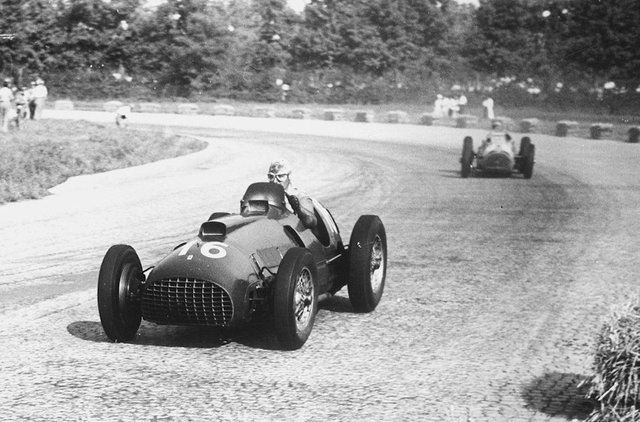 Alberto Askari on the Ferrari 375 during the Italian Grand Prix '50.
Alberto Askari on the Ferrari 375 during the Italian Grand Prix '50.
Before the World Championship '51 Ferrari won in several Great Prizes, not included in the world championship (alfa, in all of them there was no Alfa Corse), than indicated its intentions to impose the struggle of Alfa Romeo. Lamperdi equipped the engines with two spark plugs per cylinder, the power increased to 380 hp. At 7500 rpm. In Milan, for fear of increased competition, they continued to modernize their 158th. Even at last year's Grand prix of Italy, its compressor "eight" developed 370 hp. Some historians believe that it was then that the car received the index "159", others are inclined to think that the first start of the Alfa Romeo 159 was the first stage of the World Cup'51, the third - the Italian Grand Prix of the same year, when the car received a rear suspension of the type "De Dion" ". This confusion is connected with the fact that the modernization of Alfetta, and consequently its transformation from 158th to 159th, occurred gradually, from start to start: the engine's power increased, the rear suspension, fuel tanks, the power structure of the chassis changed, but the exterior The car remained practically unchanged. By the new season, engine power was raised to 404 hp, and already during the championship - up to 420 hp. At 9300 rpm. This resulted in a crazy fuel consumption - 175 liters of methyl alcohol per 100 km (after the war, alcohol was much more affordable than gasoline, in addition, Alfa Romeo engineers used the high latent heat of evaporation of alcohol - the super-rich mixture, incompletely burned, cooled the cylinder walls). Ferrari 375 required at least three times less fuel mixture, consisting of 40% methyl alcohol, 30% benzene and 30% gasoline, to overcome a similar distance.
The beginning of the championship is left for Alfa Romeo. At the Grand prix of Switzerland, the best of the Ferrari racers, Luigi Villoresi, took third place at the start, losing 3.5 seconds. Starting with the pole Fangio. "Maestro" and won the race, ahead of Finisher second-best Ferrari driver Piero Taruffi almost a minute. The next full-time duel of the Italian teams took place in the Belgian Spa. The victory was won by the current world champion Farina. Ascaris and Villoresi finished, respectively, the second and third. Grand prix of the Automobile Club of France in Rheims turned out quite interesting, because at the end of the race Fangio, to whom Luigi Fagioli lost the car, fought against Askari, who in his turn transferred Jose Froilana Gonzales to the car of Ferrari debutant. Juan Manuel was the first to cross the finish line, sharing points with 53-year-old Fagioli, who is still the most senior driver of the Formula 1 Grand Prix.
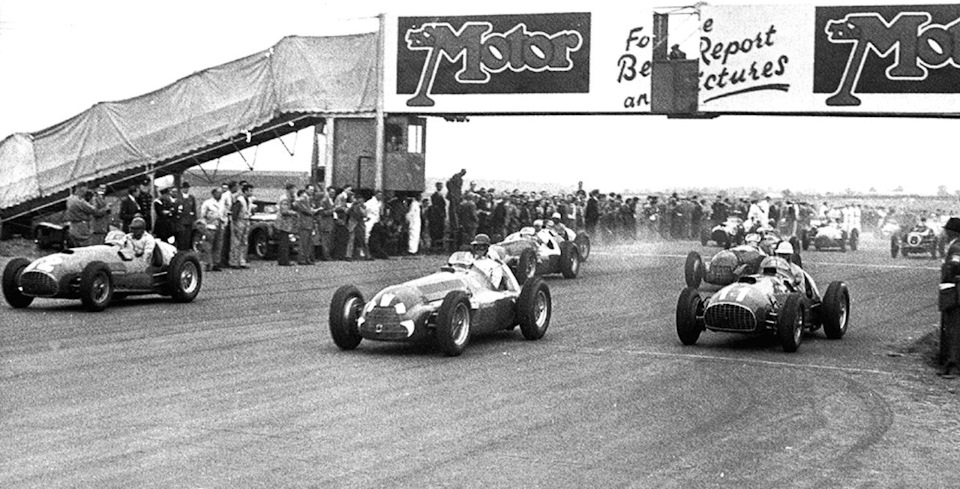 Start of the British Grand Prix '51. From left to right: Jose Freulan Gonzalez (# 12, Ferrari 375), Nino Farina (# 1, Alfa Romeo 158/159), Alberto Askari (# 11, Ferrari 375).
Start of the British Grand Prix '51. From left to right: Jose Freulan Gonzalez (# 12, Ferrari 375), Nino Farina (# 1, Alfa Romeo 158/159), Alberto Askari (# 11, Ferrari 375).
At the next stage of the '51 season, the Grand Prix of Great Britain at Silverstone, a historic event took place. Gonzalez showed a record time in the qualifying races - 1'43.4, for the first time in the history of the race track having passed the circle with an average speed of over 100 mph. Interestingly, an Argentinian, who received the nickname "Pampas Bull" for his colorful appearance, did this on the old version of the Ferrari 375, with 12 spark plugs. His best friend Fangio lost exactly one second, Farina - 1.6 seconds, team-mates, Askari and Villoresi on cars with 24 candles, respectively, 2 and 2.4 seconds. At the start, Jose Froilan missed the perfectly started Felice Bonetto on the "Alpha", but already through the circle went to the leaders, and to the fifth round ahead of Fahio followed by 5.8 seconds. On the 10th lap, the leadership moved to the "Maestro", but Gonzalez pursued him almost closely and on the 38th round held a retaliatory attack. After the first refueling, Fangio lost more than a minute to his compatriot. At the 76th lap out of 90, the Pampas Bull went into the pits for the first and last time. Stopping for refueling Gonzales got out of the car, thinking that like the race in Rheims it was time to give up the car to Descartes descended, but one of the mechanics sent Jose Froilon back - the replacement of racers during the race was banned by the organizers of the Grand Prix (according to another version, Alberto himself did not want to select Glory from a team-mate). Returning to the track Gonzalez brought the matter to a deserved victory, ahead of Finisher second Fangio for 51 seconds, Villoresi finished the race third. The winning series Alfa Romeo from victories in the 27 Grand Prix in a row was interrupted.
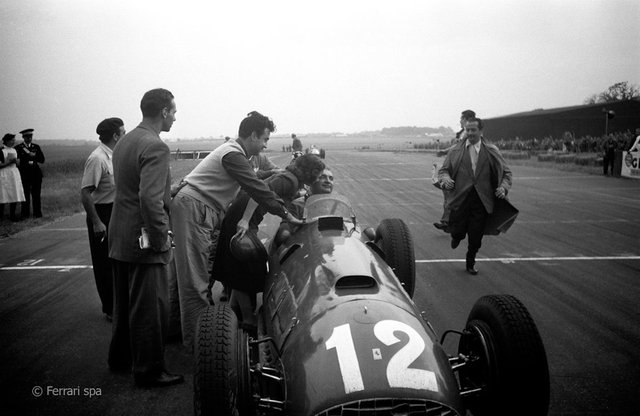 The first congratulation after the victory in the British Grand Prix, H. Gonzales receives from his wife. Enzo Ferrari was not present at the race and learned about the triumph of the phone from team manager Federico Giberti. It is said that the "Pampas Bull" has received an unprecedented privilege - to enter the Commendator's office without knocking. However, a modest Argentine never used it.
The first congratulation after the victory in the British Grand Prix, H. Gonzales receives from his wife. Enzo Ferrari was not present at the race and learned about the triumph of the phone from team manager Federico Giberti. It is said that the "Pampas Bull" has received an unprecedented privilege - to enter the Commendator's office without knocking. However, a modest Argentine never used it.
Two weeks later at the first post-war Grand Prix of Germany Alberto Askari chose to start a car with a 12-candle engine, since he considered it more elastic at medium revs, which suited the twisting Nurburgring better and was right. The Italian won the pole position, and thanks to fewer refuellings, he crossed the finish line first, for 30.5 seconds. Before Fangio. The remaining places in the scoring five remained for the pilots of Ferrari: Gonzales, Villoresi and Taruffi. To the Grand prix of Italy Alfa Romeo, in which Colombo returned again, produced three modernized "Alfette" with a modified rear end, with the rear suspension "De Dion", twin exhaust pipes, a new air intake and enlarged brake drums. Fangio and Farina were the best in the qualification, but in the race faced with technical problems. In the end, Ferrari won the winning double in Monza: Askari - the first, Gonzalez - the second. Before the last stage of the season, Askari gave in to Fangio in the World Championship only two points, and Gonzales - six
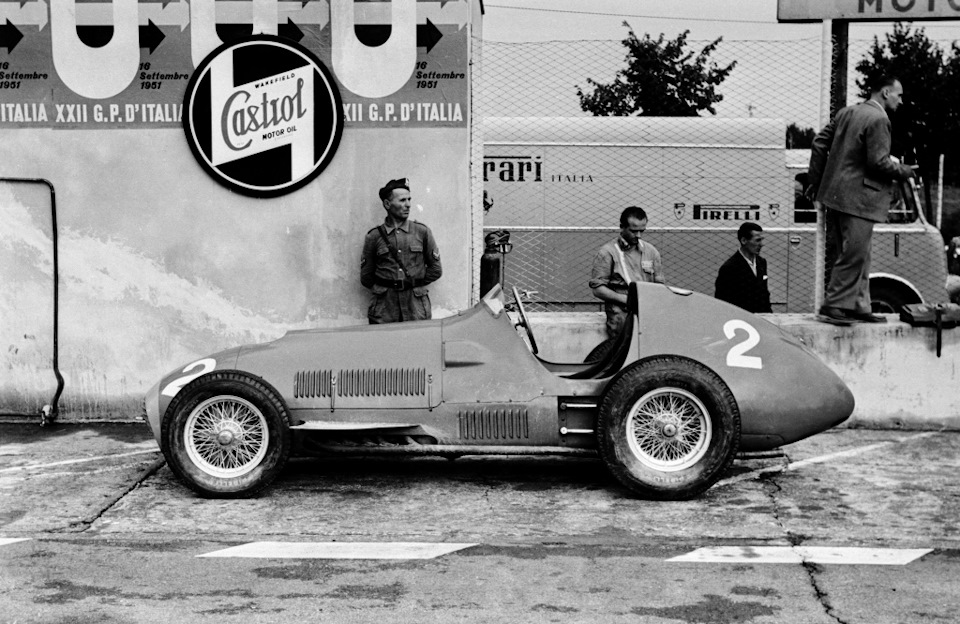 Car Alberto Askari at the pit lane of the motor racing circuit in Monza during the Italian Grand Prix '51.
Car Alberto Askari at the pit lane of the motor racing circuit in Monza during the Italian Grand Prix '51.
The season finale took place in a suburb of Barcelona, on the high-speed street road Pedralbes. Alberto Askari won the pole position, showing the result of 2'10.59, Fangio's best time was 1.5 seconds. worse. The remaining two places in the first row went to Gonzales and Farina. Ascari won the start, but already on the 4th lap passed Fangio ahead. The further race has turned for Ferrari in a nightmare. On the 6th lap the tire ripped off from Taruffi, Villaresi suffered from the same circle, two more - Askari, and later Gonzales. It became obvious that in Ferrari, choosing 16-inch wheels instead of 18-inch wheels, as they did in the remaining teams led by Alfa Romeo, made a big mistake - the tires could not stand the load of fuel tanks filled with a string and a speed line on Franco Avenue. Tires on the car Ascari burst twice more, at Tariuffi and at all the wheel fell off, and at Villorsi the motor was bunged. The only driver of the "Scuderia", who managed to avoid repeated problems was Gonzalez, but he, despite his heroic aerobatics, was able to overtake only Farina, losing 54.3 seconds. His compatriot Fangio, who won his first league title. Askari finished the race fourth, losing to the winner two laps.
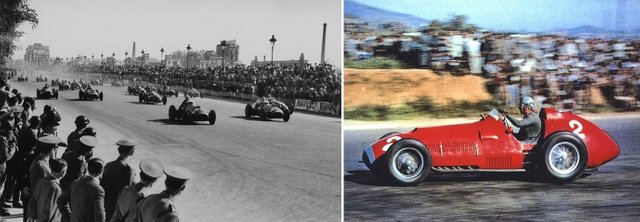 Left: Launch of the Grand prix of Spain '51. Alberto Askari (# 2) and Jose Freulan Gonzalez (# 6, both Ferrari 375) started better than Nino Farina (the far right, # 20) and Juan Manuel Fangio (behind, # 22, both - Alfa Romeo 159). Right: Askari during the race.
Left: Launch of the Grand prix of Spain '51. Alberto Askari (# 2) and Jose Freulan Gonzalez (# 6, both Ferrari 375) started better than Nino Farina (the far right, # 20) and Juan Manuel Fangio (behind, # 22, both - Alfa Romeo 159). Right: Askari during the race.
Alfa Romeo, not finding the means to build a new machine, designed by Joaquin Colombo Tipo 160 with a horizontally opposed 12-cylinder engine and the location of the rider behind the rear axle, left Formula One. Along with the departure of Alfa Romeo, the compressor engines of Grand Prix cars were gone, before the debut of the turbo-engine Renault in 1977, atmospheric engines were considered the only true solution. FIA under the influence of the organizers of the Grand prix, who feared that now the world championship will become the dominance of Ferrari, decides to hold the next two championships in the Formula-2 class. This step really added cars to the starting field, that's just the struggle did not work. The new Ferrari 500 with a 2-liter in-line 4-cylinder engine lost only one, the last, race in two years, and Alberto Askari twice became World Champion.
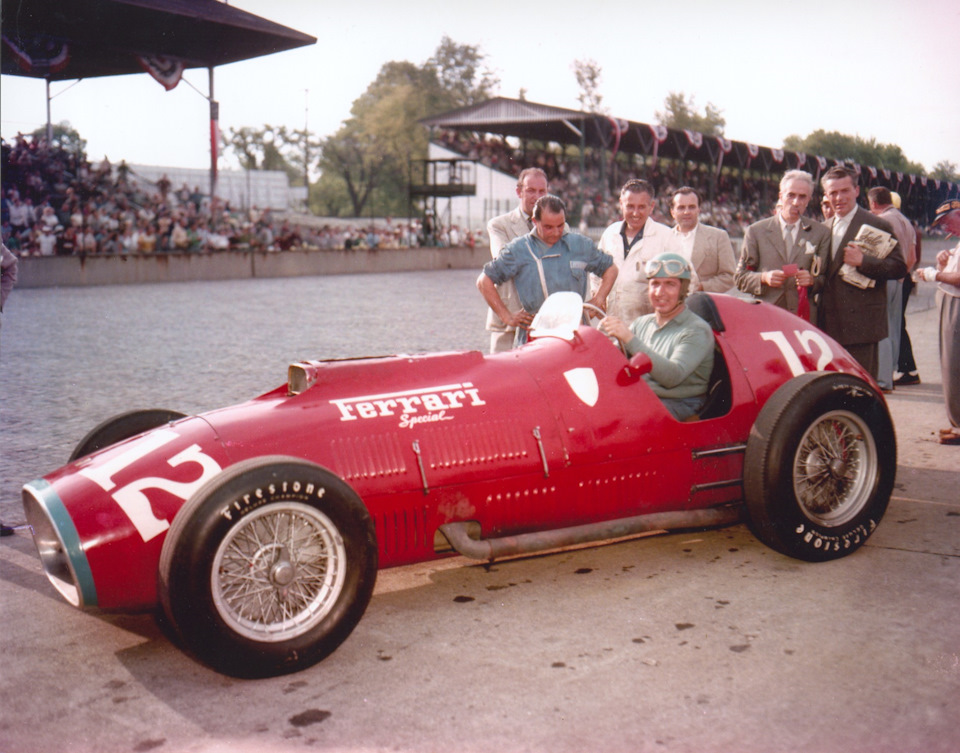 Alberto Askari at the Ferrari Special in Indianapolis. 1952 year.
Alberto Askari at the Ferrari Special in Indianapolis. 1952 year.
After the transition of the World Championship to the F-2 regulations, the sports life of the 375th did not end. The cars continued to go to the start and brought several victories in the Grand Prix, held according to the rules of F-1 and not included in the championship, until in 1954 the new regulations came into effect. In addition, when in 1952 Enzo Ferrari decided to conquer the Indy-500, which in those years included in the World Championship but was carried out according to his own technical requirements, Aurelio Lamprei modernized four Ferrari 375s to participate in the most famous overseas race. The car, called the Ferrari Special, received an elongated base, reinforced with a spatial construction of small diameter pipes and a different front cover. When during the training it became clear that the only driver of the Scuderia Alberto Askari (three more cars were sold to American racers Johnny Mauro, Howard Kek and the winner of the Indy-500 and the AAA Champion Johnny Parsons) runs the risk of not getting to the start due to the low average speed On the oval (132 mph, when most participants showed 135 mph), the two-chamber carburetors were replaced by the four-chamber Weber 40IF4C. Askari showed the 18th time in qualifying (134.3 miles per hour at a pole of 138.0 miles per hour), and in the race "Ferrari" again brought the wheels. On the 41st lap, making it to the eighth position, Askari descends from the collapsed hub of the Borrani spoke wheel. The Italians did not take into account the experience of American colleagues who switched to molybdenum magnesium disks Halibrand, and abandoned them for aesthetic reasons. The cars sold to the Americans did not go to start the Indy-500, but later they set speed records, won mountain races and even started at Pikes Peak.
Despite the modest statistics, the Ferrari 375 occupies a special place not only in the history of Scuderia, but also in motor sport in general. After all, this car, in fact, opened a new chapter in the Grand Prix racing - the era of the dominance of atmospheric engines, which lasted almost three decades.
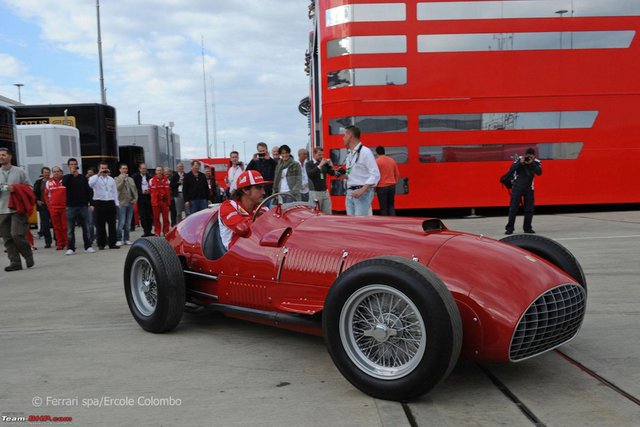 Fernando Alonso tried Ferrari 375 on the weekend of the British Grand Prix weekend, 11 when Scuderia celebrated the 60th anniversary of the first victory in the World Cup. In 2001, the circle on Silverstone in the same car was made by Michael Schumacher.
Fernando Alonso tried Ferrari 375 on the weekend of the British Grand Prix weekend, 11 when Scuderia celebrated the 60th anniversary of the first victory in the World Cup. In 2001, the circle on Silverstone in the same car was made by Michael Schumacher.
(In the post, photos from the following Internet resources were used: taringa.net, 70.ferrari.com, imgur.com, grandprixengines.co.uk, wheelsage.org, primotipo.com, f1fanatic.co.uk, 8000vueltas.com, photobucket. Com, ceskeokruhy.cz, team-bhp.com.)